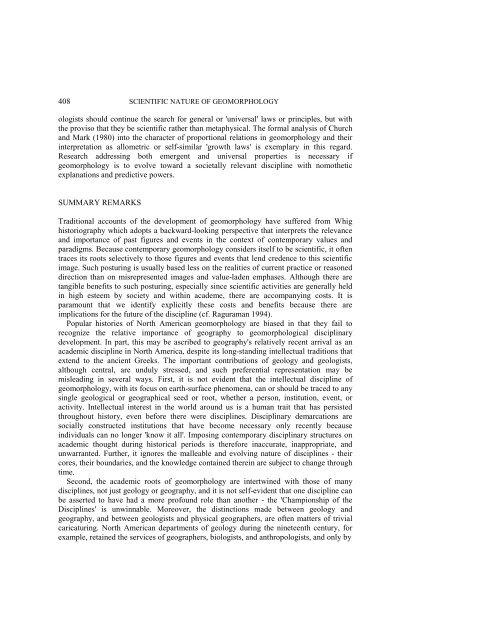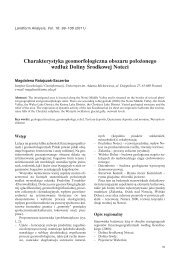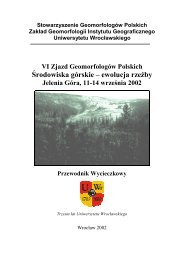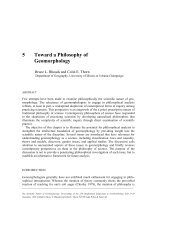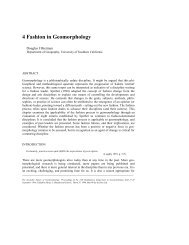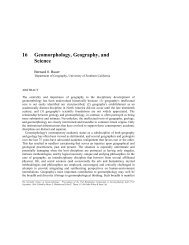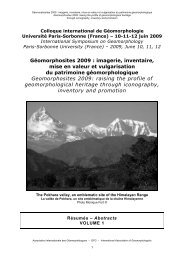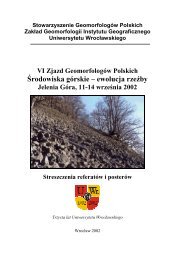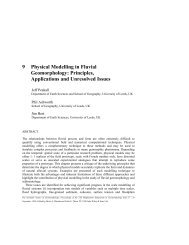Chapter 16 - Geomorphology, Geography, and Science Bernard 0
Chapter 16 - Geomorphology, Geography, and Science Bernard 0
Chapter 16 - Geomorphology, Geography, and Science Bernard 0
You also want an ePaper? Increase the reach of your titles
YUMPU automatically turns print PDFs into web optimized ePapers that Google loves.
408 SCIENTIFIC NATURE OF GEOMORPHOLOGY<br />
ologists should continue the search for general or 'universal' laws or principles, but with<br />
the proviso that they be scientific rather than metaphysical. The formal analysis of Church<br />
<strong>and</strong> Mark (1980) into the character of proportional relations in geomorphology <strong>and</strong> their<br />
interpretation as allometric or self-similar 'growth laws' is exemplary in this regard.<br />
Research addressing both emergent <strong>and</strong> universal properties is necessary if<br />
geomorphology is to evolve toward a societally relevant discipline with nomothetic<br />
explanations <strong>and</strong> predictive powers.<br />
SUMMARY REMARKS<br />
Traditional accounts of the development of geomorphology have suffered from Whig<br />
historiography which adopts a backward-looking perspective that interprets the relevance<br />
<strong>and</strong> importance of past figures <strong>and</strong> events in the context of contemporary values <strong>and</strong><br />
paradigms. Because contemporary geomorphology considers itself to be scientific, it often<br />
traces its roots selectively to those figures <strong>and</strong> events that lend credence to this scientific<br />
image. Such posturing is usually based less on the realities of current practice or reasoned<br />
direction than on misrepresented images <strong>and</strong> value-laden emphases. Although there are<br />
tangible benefits to such posturing, especially since scientific activities are generally held<br />
in high esteem by society <strong>and</strong> within academe, there are accompanying costs. It is<br />
paramount that we identify explicitly these costs <strong>and</strong> benefits because there are<br />
implications for the future of the discipline (cf. Raguraman 1994).<br />
Popular histories of North American geomorphology are biased in that they fail to<br />
recognize the relative importance of geography to geomorphological disciplinary<br />
development. In part, this may be ascribed to geography's relatively recent arrival as an<br />
academic discipline in North America, despite its long-st<strong>and</strong>ing intellectual traditions that<br />
extend to the ancient Greeks. The important contributions of geology <strong>and</strong> geologists,<br />
although central, are unduly stressed, <strong>and</strong> such preferential representation may be<br />
misleading in several ways. First, it is not evident that the intellectual discipline of<br />
geomorphology, with its focus on earth-surface phenomena, can or should be traced to any<br />
single geological or geographical seed or root, whether a person, institution, event, or<br />
activity. Intellectual interest in the world around us is a human trait that has persisted<br />
throughout history, even before there were disciplines. Disciplinary demarcations are<br />
socially constructed institutions that have become necessary only recently because<br />
individuals can no longer 'know it all'. Imposing contemporary disciplinary structures on<br />
academic thought during historical periods is therefore inaccurate, inappropriate, <strong>and</strong><br />
unwarranted. Further, it ignores the malleable <strong>and</strong> evolving nature of disciplines - their<br />
cores, their boundaries, <strong>and</strong> the knowledge contained therein are subject to change through<br />
time.<br />
Second, the academic roots of geomorphology are intertwined with those of many<br />
disciplines, not just geology or geography, <strong>and</strong> it is not self-evident that one discipline can<br />
be asserted to have had a more profound role than another - the 'Championship of the<br />
Disciplines' is unwinnable. Moreover, the distinctions made between geology <strong>and</strong><br />
geography, <strong>and</strong> between geologists <strong>and</strong> physical geographers, are often matters of trivial<br />
caricaturing. North American departments of geology during the nineteenth century, for<br />
example, retained the services of geographers, biologists, <strong>and</strong> anthropologists, <strong>and</strong> only by


